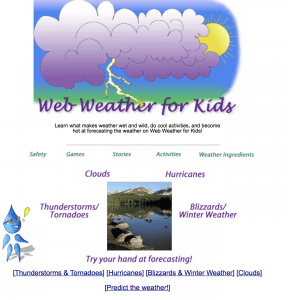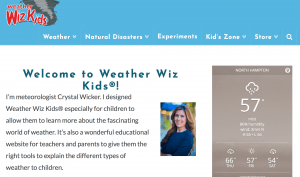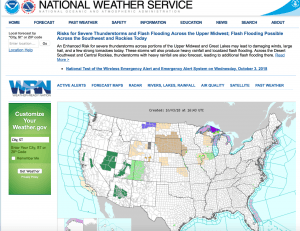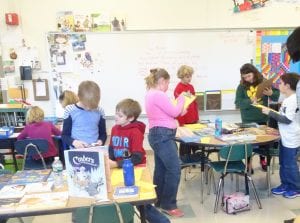 Thanks for supporting our reading museum and helping the children take note of he fact that learning continues on and on. Thank you also for your attention to making time for homework. Many of the kids were super excited about having that responsibility. We began our week by thinking about a series of precepts: “If at first you don’t succeed, try, try again.”, “Practice makes perfect.”, “”Whether you think you can or whether you think you can’t, you’re probably right.”, and ”Practice makes progress.” We had some great conversation about what we can do to make sure learning grows.
Thanks for supporting our reading museum and helping the children take note of he fact that learning continues on and on. Thank you also for your attention to making time for homework. Many of the kids were super excited about having that responsibility. We began our week by thinking about a series of precepts: “If at first you don’t succeed, try, try again.”, “Practice makes perfect.”, “”Whether you think you can or whether you think you can’t, you’re probably right.”, and ”Practice makes progress.” We had some great conversation about what we can do to make sure learning grows.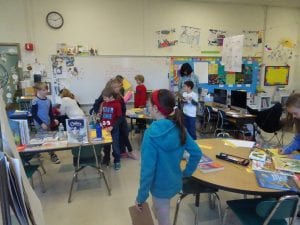
This week everyone created a second blog post, more of the children were able to solidify and apply their understanding of the distributive property during daily problem solving and we defined the criteria we would use to create “great” pieces of informational weather writing.
Reading Grows
This week we shared books important to each of us as readers. The class shared favorite books read when they were babies, read-alouds they loved hearing over and over and over again as toddlers and favorite chapter books shared as a family. It was fun to tour the class’s reading museum. Some children realized they had brought in the same book. (I discovered that Good Night Construction Siteis a must for our grandson, James.) Others were reminded of favorites from the past. It was fun to revisit books that may not have been looked at for a while.
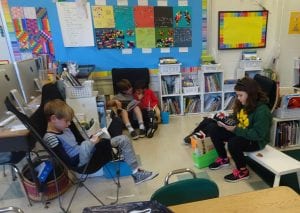 After the museum on Tuesday, we reflected on the reading we’d been doing in the first month and a half of school. We thought about the books we’d been choosing to read and we considered the difference between “reading”, “skimming and scanning” and “looking through.” All are important habits to have, but we agreed that much of the time we have in our classroom with books should be dedicated to reading. The only way to grow as a reader is to practice. We reflected on what we’d been reading so far and the school year, and what habits we’d been most focused on. Are next steps will be to develop goals that will lead us forward and help us to grow.
After the museum on Tuesday, we reflected on the reading we’d been doing in the first month and a half of school. We thought about the books we’d been choosing to read and we considered the difference between “reading”, “skimming and scanning” and “looking through.” All are important habits to have, but we agreed that much of the time we have in our classroom with books should be dedicated to reading. The only way to grow as a reader is to practice. We reflected on what we’d been reading so far and the school year, and what habits we’d been most focused on. Are next steps will be to develop goals that will lead us forward and help us to grow.
Multiplying With Large Amounts
 We’ve been learning how to use what we know about place value to help us multiply larger amounts. We’ve been trying to use the distributive property, because these steps more often help us with accuracy. They remind use to multiply everything – not just the hundreds and tens, but also the ones.
We’ve been learning how to use what we know about place value to help us multiply larger amounts. We’ve been trying to use the distributive property, because these steps more often help us with accuracy. They remind use to multiply everything – not just the hundreds and tens, but also the ones.
The problems have been written to help the children practice using this skill to become more efficient. More and more of the children are feeling sure of themselves with this strategy.
Experimenting with Leads /
Establishing the Guideline We Plan to Follow for Our Weather Writing
 We learned about four different types of leads: snapshot, question, dialogue and onomatopoeia. We had a go at playing around with each of them. We’ve tried choosing words that paint a picture. We’ve thought about the sounds we’d hear if we were to enter the setting of our piece of writing to consider if that would make an impactful start. We’ve thought of creating characters to speak and introduce our topic or story. And finally, we’ve wonder about the questions we hope our writing will answer. See if your child can tell you about the lead he or she is most interested in using to introduce readers to weather.
We learned about four different types of leads: snapshot, question, dialogue and onomatopoeia. We had a go at playing around with each of them. We’ve tried choosing words that paint a picture. We’ve thought about the sounds we’d hear if we were to enter the setting of our piece of writing to consider if that would make an impactful start. We’ve thought of creating characters to speak and introduce our topic or story. And finally, we’ve wonder about the questions we hope our writing will answer. See if your child can tell you about the lead he or she is most interested in using to introduce readers to weather.
In addition to leads we also agreed on the writing criteria we’d have for our weather writing. We thought each piece should be at least five pages (have five subtopics), and each page should have at least five sentences. We decided that our writing should how our understanding of the topic so that readers would find it interesting. And we thought we should include one illustration. Many of the students are continuing to research, but some of them are already at the writing phase. Some are typing on computers, while others are choosing to handwrite their pieces. In addition to publishing them so we have a weather library in the hall for others to read, the children are excited about posting them on their blogs for all to read.
Bits and Pieces
 We’ve posted our second blog post. This post features a personal favorite, hobby or interest. With this post we learned how to copy and paste text from one file to another. It will take time but, with practice, this will become second nature.
We’ve posted our second blog post. This post features a personal favorite, hobby or interest. With this post we learned how to copy and paste text from one file to another. It will take time but, with practice, this will become second nature.- We also learned about making quality comments. We’re trying to begin with a specific compliment that lets the blogger know we actually read the post. Then we’re trying to add a connection or question to get a conversation going. And finally we’re trying to remember to sign our names so the blogger knows we visited.
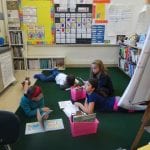
- A HUGE thank you to those who have commented and shared the URL with family and friend. Comments are motivating.
- In Open Circle we’ve discussed positive self-talk and growth mind-set. We are trying to be as encouraging to ourselves (and our classmates) as possible.
- Our next field trip will be to Strawberry Banke. It is on Monday, November 19. Permission slips went home on Wednesday. The cost of the trip is $5.00. We’ll be learning all about Thanksgiving through the ages as we travel from house to house and learn how the celebration has changed.
There is an Early Release on Wednesday, October 24.
Dismissal is at 12:00.

 Gecko
Gecko
 We are very busy. We’re trying to establish a safe habit for our class reptile – leopard geckos. They live in the desert so it has to be hot. We are trying to find a safe way to make sure the temperature doesn’t drop too much at night and on the weekends. It’s been an interesting and exciting process. We also had the opportunity (a high pressure system moving in) to set up our storm glass so now our weather corner has another tool that we can use to predict the weather.
We are very busy. We’re trying to establish a safe habit for our class reptile – leopard geckos. They live in the desert so it has to be hot. We are trying to find a safe way to make sure the temperature doesn’t drop too much at night and on the weekends. It’s been an interesting and exciting process. We also had the opportunity (a high pressure system moving in) to set up our storm glass so now our weather corner has another tool that we can use to predict the weather.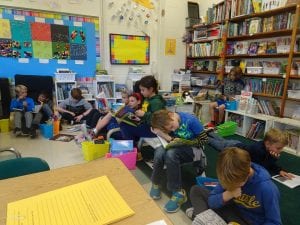 This week we’ve spent time thinking about goals. We’ve tried to be specific. We’ve tried to make our goals about something important and doable. We’re also thinking about the evidence we might collect to show we have accomplished our goals.
This week we’ve spent time thinking about goals. We’ve tried to be specific. We’ve tried to make our goals about something important and doable. We’re also thinking about the evidence we might collect to show we have accomplished our goals. Once we discovered what we might do to grow as readers, we set a goal for the week. We called it a W.O.W. (within one week) goal. We’ve discovered that even though we know how we might improve our reading skills, we don’t always do what will help us. We really do have to make a plan if we are going to accomplish what we set out to do. We’re trying to explore new books and spend more time thinking about what we’re reading. They deserve to be proud of all they are attempting and doing as readers.
Once we discovered what we might do to grow as readers, we set a goal for the week. We called it a W.O.W. (within one week) goal. We’ve discovered that even though we know how we might improve our reading skills, we don’t always do what will help us. We really do have to make a plan if we are going to accomplish what we set out to do. We’re trying to explore new books and spend more time thinking about what we’re reading. They deserve to be proud of all they are attempting and doing as readers.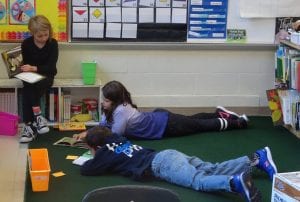 This month our calendar is filled with a pattern of polygons. We’re learning about different types of triangles, quadrilaterals, pentagons and hexagons. We’ve discovered that when they are called “regular” shapes the sides and angles are equal. “Regular” shapes often have many lines of symmetry. Symmetry is all around us. We’ve looked for things in the classroom that are symmetrical and we’ve explored symmetry in nature too.
This month our calendar is filled with a pattern of polygons. We’re learning about different types of triangles, quadrilaterals, pentagons and hexagons. We’ve discovered that when they are called “regular” shapes the sides and angles are equal. “Regular” shapes often have many lines of symmetry. Symmetry is all around us. We’ve looked for things in the classroom that are symmetrical and we’ve explored symmetry in nature too.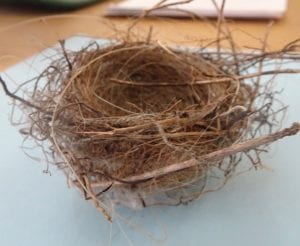 Survival
Survival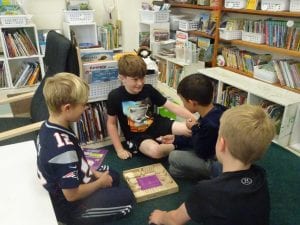 The Wild Robot
The Wild Robot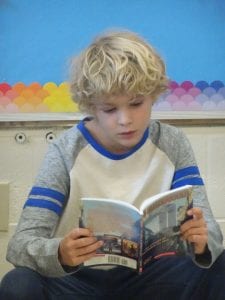 3rd Grade Challenges – 3E
3rd Grade Challenges – 3E We are having lots of fun blogging. Thank you so much for the wonderful comments. Having an audience for our writing and our ideas is very motivating.
We are having lots of fun blogging. Thank you so much for the wonderful comments. Having an audience for our writing and our ideas is very motivating. Thanks for supporting our reading museum and helping the children take note of he fact that learning continues on and on. Thank you also for your attention to making time for homework. Many of the kids were super excited about having that responsibility. We began our week by thinking about a series of precepts: “If at first you don’t succeed, try, try again.”, “Practice makes perfect.”, “”Whether you think you can or whether you think you can’t, you’re probably right.”, and ”Practice makes progress.” We had some great conversation about what we can do to make sure learning grows.
Thanks for supporting our reading museum and helping the children take note of he fact that learning continues on and on. Thank you also for your attention to making time for homework. Many of the kids were super excited about having that responsibility. We began our week by thinking about a series of precepts: “If at first you don’t succeed, try, try again.”, “Practice makes perfect.”, “”Whether you think you can or whether you think you can’t, you’re probably right.”, and ”Practice makes progress.” We had some great conversation about what we can do to make sure learning grows.
 After the museum on Tuesday, we reflected on the reading we’d been doing in the first month and a half of school. We thought about the books we’d been choosing to read and we considered the difference between “reading”, “skimming and scanning” and “looking through.” All are important habits to have, but we agreed that much of the time we have in our classroom with books should be dedicated to reading. The only way to grow as a reader is to practice. We reflected on what we’d been reading so far and the school year, and what habits we’d been most focused on. Are next steps will be to develop goals that will lead us forward and help us to grow.
After the museum on Tuesday, we reflected on the reading we’d been doing in the first month and a half of school. We thought about the books we’d been choosing to read and we considered the difference between “reading”, “skimming and scanning” and “looking through.” All are important habits to have, but we agreed that much of the time we have in our classroom with books should be dedicated to reading. The only way to grow as a reader is to practice. We reflected on what we’d been reading so far and the school year, and what habits we’d been most focused on. Are next steps will be to develop goals that will lead us forward and help us to grow. We’ve been learning how to use what we know about place value to help us multiply larger amounts. We’ve been trying to use the distributive property, because these steps more often help us with accuracy. They remind use to multiply everything – not just the hundreds and tens, but also the ones.
We’ve been learning how to use what we know about place value to help us multiply larger amounts. We’ve been trying to use the distributive property, because these steps more often help us with accuracy. They remind use to multiply everything – not just the hundreds and tens, but also the ones. We learned about four different types of leads: snapshot, question, dialogue and onomatopoeia. We had a go at playing around with each of them. We’ve tried choosing words that paint a picture. We’ve thought about the sounds we’d hear if we were to enter the setting of our piece of writing to consider if that would make an impactful start. We’ve thought of creating characters to speak and introduce our topic or story. And finally, we’ve wonder about the questions we hope our writing will answer. See if your child can tell you about the lead he or she is most interested in using to introduce readers to weather.
We learned about four different types of leads: snapshot, question, dialogue and onomatopoeia. We had a go at playing around with each of them. We’ve tried choosing words that paint a picture. We’ve thought about the sounds we’d hear if we were to enter the setting of our piece of writing to consider if that would make an impactful start. We’ve thought of creating characters to speak and introduce our topic or story. And finally, we’ve wonder about the questions we hope our writing will answer. See if your child can tell you about the lead he or she is most interested in using to introduce readers to weather. We’ve posted
We’ve posted 

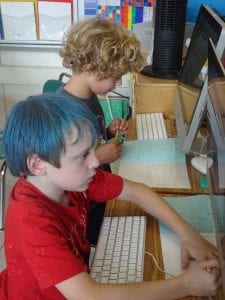
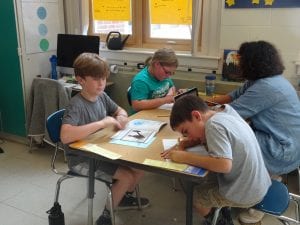
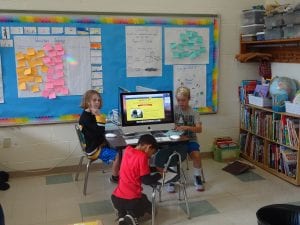 For a short week, we certainly fit a lot in. We continued our weather research. We’re finding out a lot of interesting facts. We began student blogging this week. The class is very excited about creating a first post. Thanks to those families who were able to read them and leave a comment. Please share the blog url with family and friends, near and far. It is exciting to open the blogs and find comments from grandparents, aunts and uncles. Thank you for your time and attention with this.
For a short week, we certainly fit a lot in. We continued our weather research. We’re finding out a lot of interesting facts. We began student blogging this week. The class is very excited about creating a first post. Thanks to those families who were able to read them and leave a comment. Please share the blog url with family and friends, near and far. It is exciting to open the blogs and find comments from grandparents, aunts and uncles. Thank you for your time and attention with this.

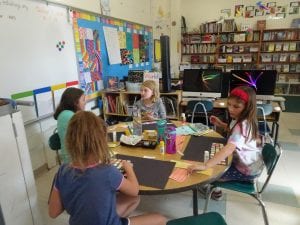 We’ve been learning how to create and read arrays. This practice enabled all of us to understand how the Commutative Property of Multiplication works. It doesn’t matter if you have 3 rows of 4 or 4 rows of 3. Both equal twelve. To show this understanding we made buildings to create Multiplication Main Street. Our buildings show how this property works.
We’ve been learning how to create and read arrays. This practice enabled all of us to understand how the Commutative Property of Multiplication works. It doesn’t matter if you have 3 rows of 4 or 4 rows of 3. Both equal twelve. To show this understanding we made buildings to create Multiplication Main Street. Our buildings show how this property works.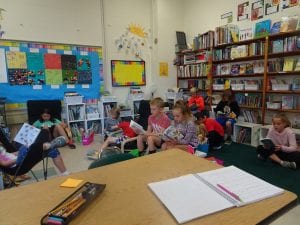
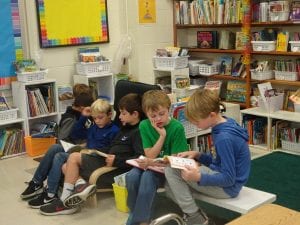
 We’ve begun our
We’ve begun our 
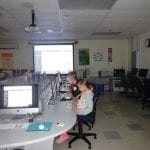 We have continued to work on our
We have continued to work on our 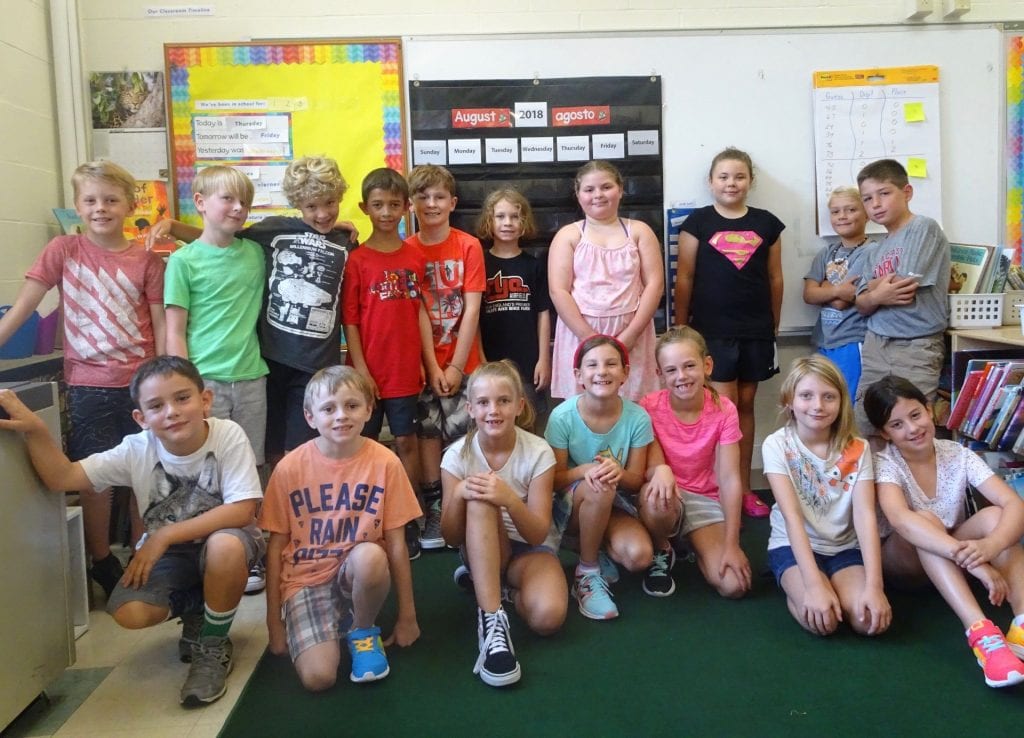
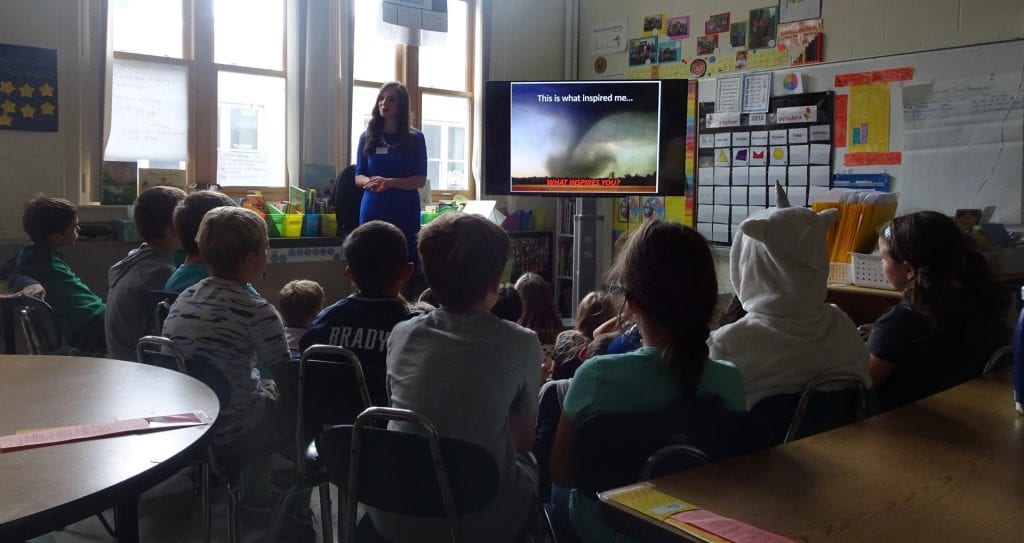 Our week seems to fly by. I guess that’s a good thing – we are exploring lots of things every day and all seem to be enjoying what we are doing. This week we finished our third chapter read-aloud for the year. With the help of Mrs. Wyman, the students were each able to take the first step in setting up their personal learning blog. We’ve begun our first research project and feel surer about how the commutative property of multiplication works.
Our week seems to fly by. I guess that’s a good thing – we are exploring lots of things every day and all seem to be enjoying what we are doing. This week we finished our third chapter read-aloud for the year. With the help of Mrs. Wyman, the students were each able to take the first step in setting up their personal learning blog. We’ve begun our first research project and feel surer about how the commutative property of multiplication works. During our Open Circle discussions during the last few weeks we’ve been discussing feeling and emotions. We’ve sorted them, calling some uncomfortable and other comfortable. We’ve wondered if we always know how we are feeling – we’ve discussed how breathing can help us relax. We’ve also discovered that we can read other people’s emotions by paying attention to their body language.
During our Open Circle discussions during the last few weeks we’ve been discussing feeling and emotions. We’ve sorted them, calling some uncomfortable and other comfortable. We’ve wondered if we always know how we are feeling – we’ve discussed how breathing can help us relax. We’ve also discovered that we can read other people’s emotions by paying attention to their body language.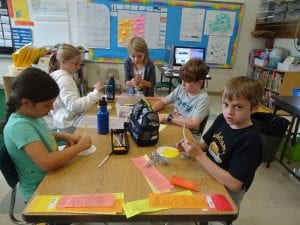 Our goal in daily problem solving is to offer the children opportunities to practice logical thinking and to find ways to use new knowledge to become more efficient over time. The children choose a strategy they can use to document their thinking and follow through to an accurate solution. This is challenging. When you and I read the problems we see that most of them can be solved with multiplication, but because it is still new to your children, it is not always their choice.
Our goal in daily problem solving is to offer the children opportunities to practice logical thinking and to find ways to use new knowledge to become more efficient over time. The children choose a strategy they can use to document their thinking and follow through to an accurate solution. This is challenging. When you and I read the problems we see that most of them can be solved with multiplication, but because it is still new to your children, it is not always their choice. At this point you’ll notice any range of strategies. Sometime the children are drawing out the problems. This can become cumbersome and mistakes are often made when counting. Sometimes children are skip counting or using a doubling strategy. Sometimes children are able to mentally manipulate amounts in their minds but are off by a bit when the value of a digit is confused. Each child is using what s/he knows to solve the problem, and with time will become more efficient. With time you’ll see changes and progress. We’ll be keeping samples of problems in the classroom to document growth. You may want to do that too so you can share the growth that you see when you look at problems from across the year and notice as more sophisticated strategies are being used with all four operations.
At this point you’ll notice any range of strategies. Sometime the children are drawing out the problems. This can become cumbersome and mistakes are often made when counting. Sometimes children are skip counting or using a doubling strategy. Sometimes children are able to mentally manipulate amounts in their minds but are off by a bit when the value of a digit is confused. Each child is using what s/he knows to solve the problem, and with time will become more efficient. With time you’ll see changes and progress. We’ll be keeping samples of problems in the classroom to document growth. You may want to do that too so you can share the growth that you see when you look at problems from across the year and notice as more sophisticated strategies are being used with all four operations.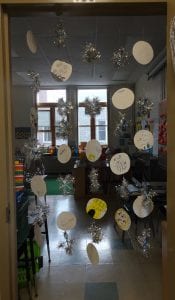 When we completed I Survived the Children’s Blizzard of 1888,we celebrated that accomplishment by having each child illustrate a snowball with their favorite scene and create a snowflake to be part of our
When we completed I Survived the Children’s Blizzard of 1888,we celebrated that accomplishment by having each child illustrate a snowball with their favorite scene and create a snowflake to be part of our 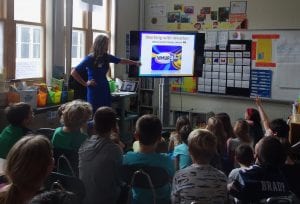 And of course,
And of course, 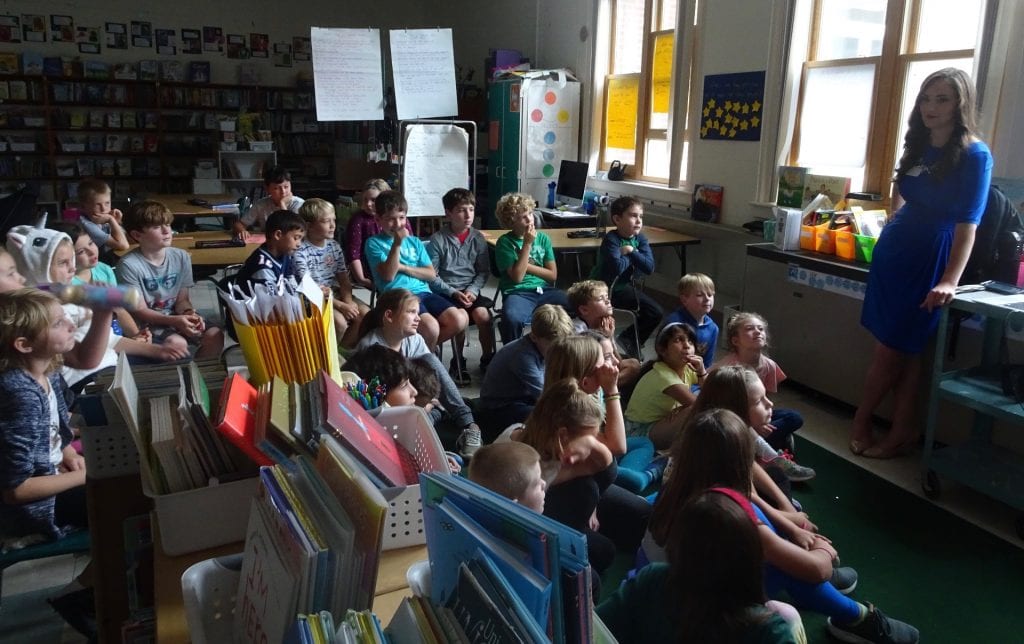

 Our first science inquiry of the year is about weather. We’ve learned a lot already and we’re excited to learn more and more. We’ve been learning about the difference between daily weather and climate. We’re recording daily weather and looking for patterns. Each morning we read the temperature and graph the weather and precipitation of the day. Soon we’ll be exploring barometric pressure as well. We are learning how to use these points of data to make reasonable predictions about what kind of weather might happen next.
Our first science inquiry of the year is about weather. We’ve learned a lot already and we’re excited to learn more and more. We’ve been learning about the difference between daily weather and climate. We’re recording daily weather and looking for patterns. Each morning we read the temperature and graph the weather and precipitation of the day. Soon we’ll be exploring barometric pressure as well. We are learning how to use these points of data to make reasonable predictions about what kind of weather might happen next.
